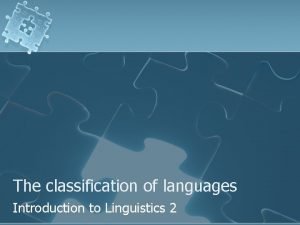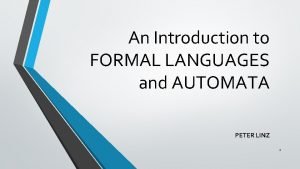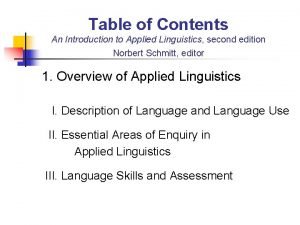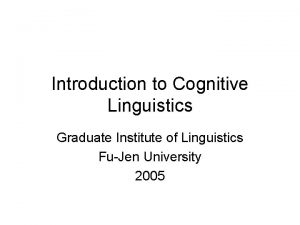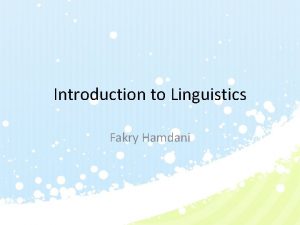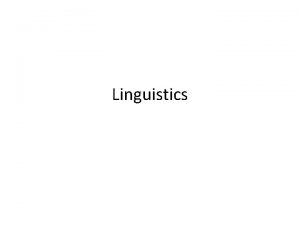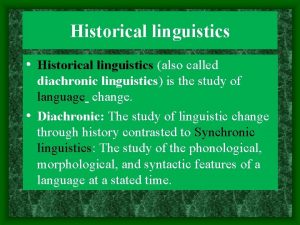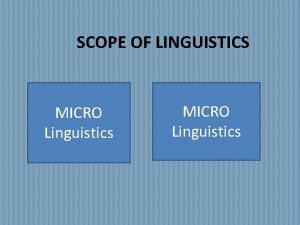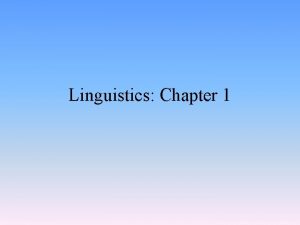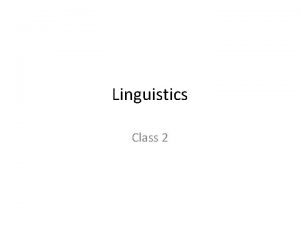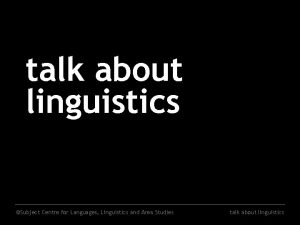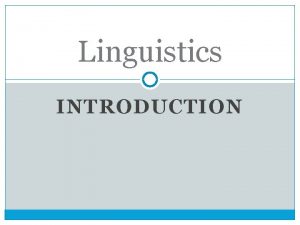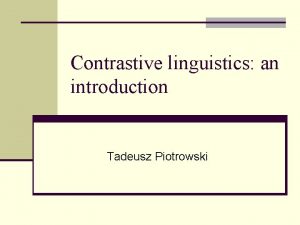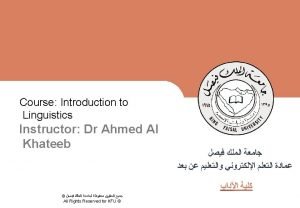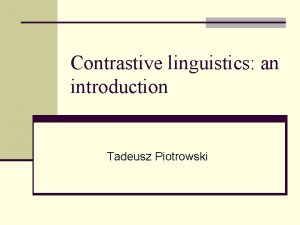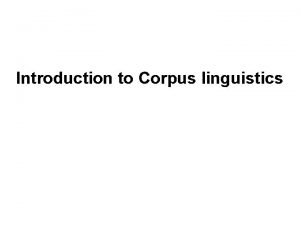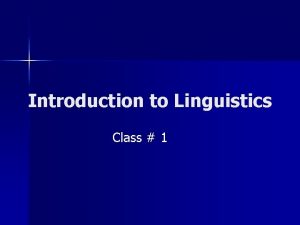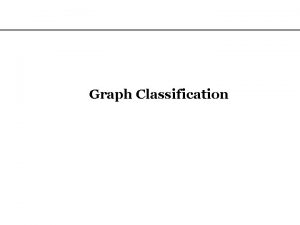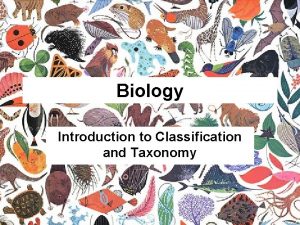The classification of languages Introduction to Linguistics 2
































- Slides: 32

The classification of languages Introduction to Linguistics 2

Defining language l Dialect and language l Defining criteria l If two speeches are mutually intelligible, they are dialects.

Fuzzy boundaries l Claimed to be one language, but there a variety of mutually unintelligible ‘dialects’. l Chinese l Taiwanese, Wu… l Cantonese, Mandarin/ Putonhua, Claimed to be two independent languages, but they are actually mutually intelligible. l Serbian and Croatian

Approaches to language classification Genetic classification l Linguistic typology l

Genetic Classification

Genetic classification Languages with related historical decent are said to be genetically related. l ‘language families’ l

Language families

Case Study: The Indo-European language family

Linguistic Typology

Linguistic typology l Languages are grouped together according to the similarities of their linguistic features.

Linguistic Universals l The common linguistic features that are found in all or most languages.

How to describe linguistic universals Absolute universals vs. universal tendencies l Implicational universals l Markedness theory l

Absolute universals vs. universal tendencies l Absolute universals l l The linguistic features that occur in ALL languages Universal tendencies l The linguistic features that occur in MOST languages

Implicational universals The presence of one linguistic feature in one language must indicate the occurrence of another. l If A is found in language L, B must be also present in language L. l The implication is one-way. l Example: l l If one language has fricative phonemes, it will also have stop phonemes

Implicational universals: Example The implication is one-way. l Example: l If one language has fricative phonemes (/s/, /z/), it will also have stop phonemes (/p/, /t/). l But not vice versa. l

Markedness theory The most common/default features are unmarked. l The less common features are marked. l

Markedness theory: example l Gender in nouns Which is marked? Masculine or feminine? l Prince-princess; actor-actress l Doctor-female doctor; nurse-male nurse l l 萬綠叢中一點紅 l Which is marked?

Typological classification by Phonology l Morphology l Syntax l

Typology: phonology Vowel systems l Consonant systems l Suprasegmental systems l Syllable structure l

Typology: phonology: vowel l Universals l The most common vowel system l 5 l vowels /a/-/i/-/u/-/e/-/o/ The most common phonemes l /a/-/i/-/u/ Front vowel phonemes are generally unrounded. l Low vowels are generally unrounded. l

Typology: phonology: Consonant l Universals All languages have stops l /p, t, k/ l The most common fricative phoneme is /s/ l Most of languages have at least one nasal. l l Implicational universals Fricatives -> stops l Voiced obstruents -> voiceless obstruents l Affricates -> stops and fricatives l

Typology: phonology: suprasemental l Types l Tone languages l Languages that use pitch to make semantic distinctions of words l Mandarin Chinese l Stress languages l Fixed stress l Free stress l Syllable structure l CV, V

Typology: morphology The isolating type l The polysynthetic type l The agglutinating type l The fusional type l

Typology: morphology: The isolating/analytic type l One word represents one single morpheme. l l No affixes Mandarin Chinese

Typology: morphology: The polysynthetic type One single word with a long string of roots and affixes l The semantic equivalent of one sentence in other languages. l l Qasu-iir-sar-vig-ssar-si-ngit-luunar-puq ‘some one did not find a completely suitable resting place. ’ (Inuktitut)

Typology: morphology: The agglutinating type l An agglutinating words Contains several morphemes l The root and affixes in the words can be semantically identified. l Swahili Tu –ta –wa -on- esha we-fut. -them-see-cause 'we will show them'

An aggluinating example: Antidisestablishmentarianism l establish (9) l l dis-establish (12) l l ending the established status of a body, in particular a church, given such status by law, such as the Church of England disestablish-ment (16) l l to set up, put in place, or institute (originally from the Latin stare, to stand) the separation of church and state (specifically in this context it is the political movement of the 1860 s in Britain) anti-disestablishment (20) l opposition to disestablishment l an advocate of opposition to disestablishment l the movement or ideology that opposes disestablishment antidisestablishment-arian (25) Antidisestablishmentarian-ism (28)

Typology: morphology: The fusional/inflectional type l A fusional/inflectional word contains several morphemes which indicate grammatical categories. l Ein kleiner Hamster "a little hamster" (nominative case) l Der kleine Hamster "the little hamster" (nominative case) l l Ich sah den kleinen Hamster "I saw the little hamster" (accusative case) Mit kleinem Hamster "with little hamster" (dative case).

Typology: syntax l Word order universals SVO l SOV l VSO l

Word order: SVO l John loves Mary.

word order: SOV 私 は 箱 を 開けます。 l watashi-wa-hako-o-akemasu. l. I box open l ‘I open the box. ’ l

word order: OSV Sentence Words Parts Translation ﻗﺮﺃ ﺍﻟﻤﺪﺭﺱ ﺍﻟﻜﺘﺎﺏ ﺍﻟﻤﺪﺭﺱ ﻗﺮﺃ al-kitāba al-mudarrisu Qara'a Read. the teacher the book Object Subject Verb The teacher read the book.
 Language
Language Theoretical linguistics vs applied linguistics
Theoretical linguistics vs applied linguistics Typological classification of languages
Typological classification of languages Introduction to scripting languages
Introduction to scripting languages Introduction to programming languages
Introduction to programming languages Gtg stands for in automata
Gtg stands for in automata The study of language yule
The study of language yule Introducing phonology answer key
Introducing phonology answer key Applied linguistics
Applied linguistics Lexical category
Lexical category Hát kết hợp bộ gõ cơ thể
Hát kết hợp bộ gõ cơ thể Bổ thể
Bổ thể Tỉ lệ cơ thể trẻ em
Tỉ lệ cơ thể trẻ em Chó sói
Chó sói Tư thế worms-breton
Tư thế worms-breton Alleluia hat len nguoi oi
Alleluia hat len nguoi oi Các môn thể thao bắt đầu bằng tiếng nhảy
Các môn thể thao bắt đầu bằng tiếng nhảy Thế nào là hệ số cao nhất
Thế nào là hệ số cao nhất Các châu lục và đại dương trên thế giới
Các châu lục và đại dương trên thế giới Công thức tiính động năng
Công thức tiính động năng Trời xanh đây là của chúng ta thể thơ
Trời xanh đây là của chúng ta thể thơ Mật thư anh em như thể tay chân
Mật thư anh em như thể tay chân Phép trừ bù
Phép trừ bù độ dài liên kết
độ dài liên kết Các châu lục và đại dương trên thế giới
Các châu lục và đại dương trên thế giới Thể thơ truyền thống
Thể thơ truyền thống Quá trình desamine hóa có thể tạo ra
Quá trình desamine hóa có thể tạo ra Một số thể thơ truyền thống
Một số thể thơ truyền thống Cái miệng xinh xinh thế chỉ nói điều hay thôi
Cái miệng xinh xinh thế chỉ nói điều hay thôi Vẽ hình chiếu vuông góc của vật thể sau
Vẽ hình chiếu vuông góc của vật thể sau Nguyên nhân của sự mỏi cơ sinh 8
Nguyên nhân của sự mỏi cơ sinh 8 đặc điểm cơ thể của người tối cổ
đặc điểm cơ thể của người tối cổ


